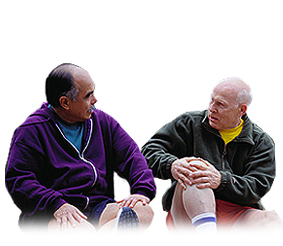Knee Pain SmartSiteTM | ||||||||||||||||||
Physical therapy for knee painDescriptionYour doctor may refer you to a physical therapist to treat your knee pain. A physical therapist will teach you exercises that will make your knee stronger. Your physical therapist also may do certain treatments to help relieve your knee pain. Physical therapy can help treat muscle strains, ligament or tendon sprains, bursitis, and arthritis. It may also help you prepare for or recover after knee-replacement surgery. The goal of physical therapy is to help you return to function. Your physical therapist can help you strengthen and stretch the muscles around your knee. You will also learn the right ways to move your knee for everyday tasks and sports activities. The treatment and exercises you learn will depend on whether you have arthritis or another type of knee injury that is causing pain. The overall approach to treating knee pain is similar. But specific exercises and therapy can help address specific problems. Getting startedThere are a lot of exercises, stretches, and other ways to treat knee pain and knee arthritis. Each physical therapist may choose a different set of exercises or treatments to help you. There is no perfect exercise or technique. It is best to focus on using the treatment and coaching you receive to help you manage your pain and decrease your risk for more injuries to your knee. Before treating you, a therapist will evaluate your body mechanics. To do this, the therapist may:
Muscle strengthening and stretchingThere are many muscles surrounding your knee. Some of them are the strongest muscles in your body. When all of the muscles around your knee are working well together, they can keep your knee joint stable. When you are active and your knee is stable, you will put less stress on your knee ligaments. After testing and examining you, your therapist will know which muscles are too weak or too tight. You will then start a program to stretch out your muscles and make them stronger. For most of these exercises, you will not need to use weights. The therapist will also check your stability and look at your back, stomach, and hip muscles. These muscles can help reduce pain in your knees. The therapist will prescribe exercises to work on building up these core muscles. When you are returning from an injury, it is important to train your knee joint, muscle, or ligament so that they don't get injured again. The therapist will make you do some cutting or jumping exercises to train and test your knee before you go back to sports again. This is an important part of rehabilitation. Incomplete therapy and rehabilitation can increase your risk of future injuries. Deep tissue work or massageA massage therapist or a physical therapist can do deep-tissue work or massage for knee pain. This type of massage is different from the type of massage that can help you relax. The goal of deep-tissue work is to break up tiny scars that can form in the muscles, tendons, and other tissues that have been sore or tight for a long time. This soreness or tightness may be caused by arthritis or sprains and strains of the muscles and ligaments around your knee. During the treatment:
Right afterward, you may feel pain or stiffness in the muscles that were worked on. Try placing ice on the area. The discomfort should go away in 1 or 2 days. Ultrasound treatmentsUltrasound is most often used to treat bursitis, inflammation, sprains, and strains around the knee. The ultrasound machine creates high-frequency sound waves. A probe that is attached to the machine carries these waves to your body tissues.
Your therapist can also do other treatments with ultrasound. Most of the time, your therapist will use ultrasound before stretching a muscle, tendon, or ligament, or before you do some exercises. All of these treatments help bring blood into the area around your knee, and this can help with the healing process. | ||||||||||||||||||
| ||||||||||||||||||
Review Date: 8/9/2018 Reviewed By: C. Benjamin Ma, MD, Professor, Chief, Sports Medicine and Shoulder Service, UCSF Department of Orthopaedic Surgery, San Francisco, CA. Also reviewed by David Zieve, MD, MHA, Medical Director, Brenda Conaway, Editorial Director, and the A.D.A.M. Editorial team. View References:  The information provided herein should not be used during any medical emergency or for the diagnosis or treatment of any medical condition. A licensed medical professional should be consulted for diagnosis and treatment of any and all medical conditions. Links to other sites are provided for information only -- they do not constitute endorsements of those other sites. No warranty of any kind, either expressed or implied, is made as to the accuracy, reliability, timeliness, or correctness of any translations made by a third-party service of the information provided herein into any other language. © 1997- A.D.A.M., a business unit of Ebix, Inc. Any duplication or distribution of the information contained herein is strictly prohibited. | ||||||||||||||||||
A.D.A.M. content is best viewed in IE9 or above, Firefox and Google Chrome browser. | ||||||||||||||||||












